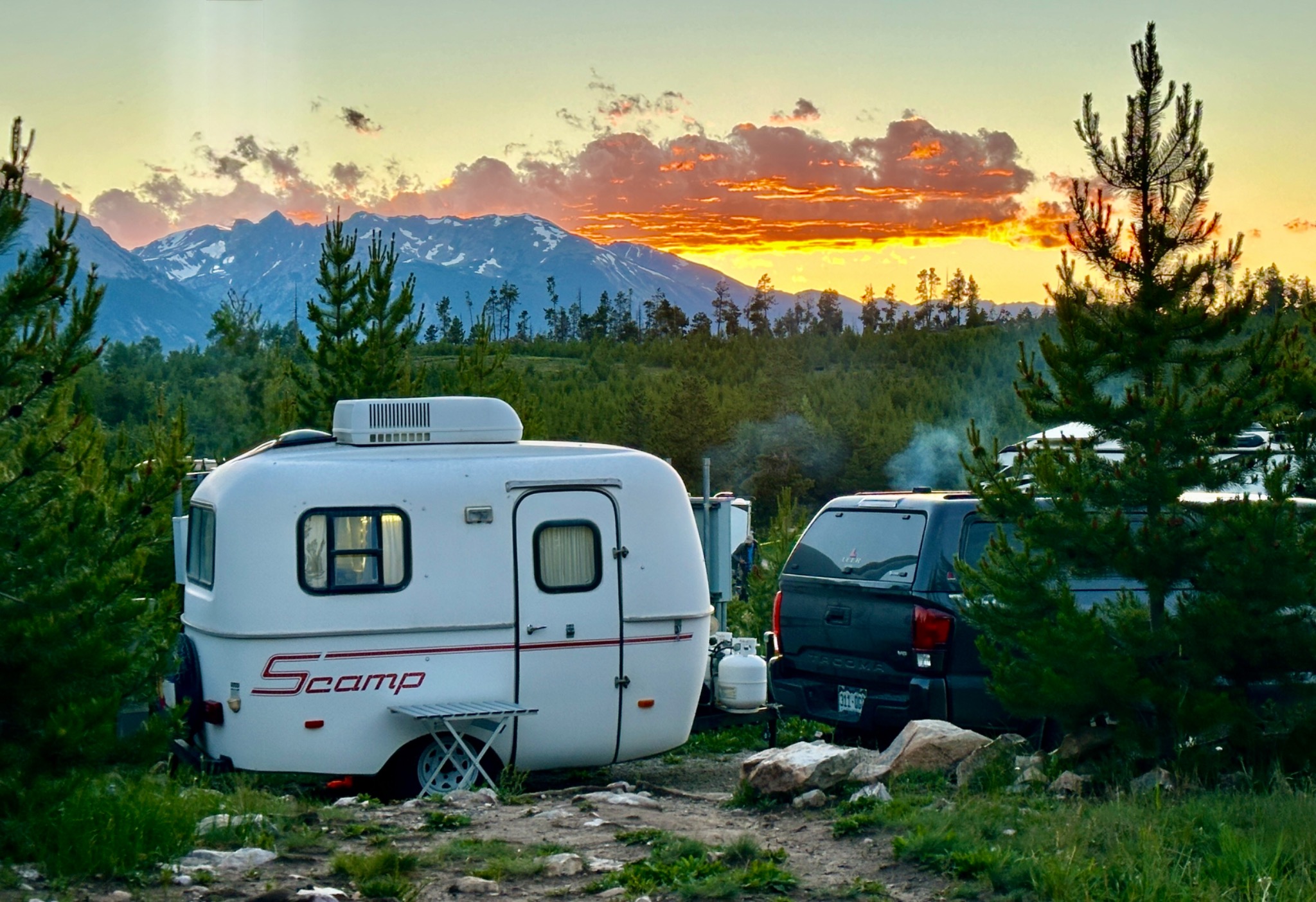
A Scamp for All Seasons
In July 2009, Sandy and I flew to Alaska to visit her family, our first time back since we had moved away four years earlier. During that week-long vacation, we took an impromptu side trip to Denali National Park and Preserve, the place where we met and began dating in 1997.
I’ve written about Denali twice before—first to honor the mountain’s true name and then to celebrate the book that led me there years ago—but this blog is about something tangential to Denali, something timely that happened on our way back from the park after that brief getaway.
As we left Denali and drove south toward Sandy’s parents’ home in Wasilla, we rounded a bend and began passing a car towing a small camper that immediately caught our attention for several reasons.
We liked its shape because it resembled a squared-off egg. We liked its hard exterior because we had just left bear country and would have preferred the added security over our nylon tent. We liked its compact size because it was the antithesis of the monstrous RVs that clog Alaska’s roadways. We liked its retro vibe, replete with an old-school logo and lettering. And we liked the camper’s name because it seemed totally on brand.
It was called a Scamp.
Yes, a Scamp, as in an appealingly mischievous person. It sounded like a perfect descriptor for this delightful little trailer that would be the ideal companion for adventures far and wide.
We knew we should check it out at some point, but what we didn’t know—what we couldn’t know—was that 16 years later, I’d be writing about this camper and its profound impact on our lives ever since we saw it on that fateful summer day.
A camper for Phil
As we watched the Scamp fade from our rear-view mirror, we made a note of its name and vowed to follow up with some online research when we flew home to Memphis a few days later.
Reading the description on scamptrailers.com and seeing photos of its throwback exterior and interior further piqued our interest. These lightweight, durable fiberglass trailers were available in three lengths: 13, 16, and 19 feet. We fixated on the 13-foot Scamp, which we felt was light enough, about 1,500 pounds, to tow with our Subaru Outback.

We learned that Scamps come equipped with all the necessities (and some optional features), including a table that converts to a bed, a kitchenette with a sink, fridge, and two-burner stove, a bathroom with a toilet and shower, an air conditioner, a furnace, and plenty of storage space.
We loved the idea of buying one for ourselves, but at that moment, we realized the Scamp would be perfect for my father, Phil.
My Dad had been widowed a year earlier when my Mom—the incomparable Kitty Smith—passed away after a lengthy battle with ovarian cancer. Dad was lonely and bored. He and his Golden Retriever Abby needed something to get them out of the house. What would be better than a lightweight, easily maneuverable camper that he could tow with his current vehicle?
One August night at Memphis Pizza Café—our favorite joint for enjoying a delicious pie and several cold beers with Phil—we mentioned the Scamp, showed him the online brochure, and asked what he thought about buying one. In an instant (and perhaps it was the Bud Light talking), he was as hooked as we had been a month earlier in Alaska.
He was more hooked, in fact, because a few weeks later, he called the Scamp dealership in Backus, Minn., and custom-ordered a camper. A few months after that, his new 13-foot Scamp was delivered to his home in Germantown. The following spring, he was ready to hit the road.
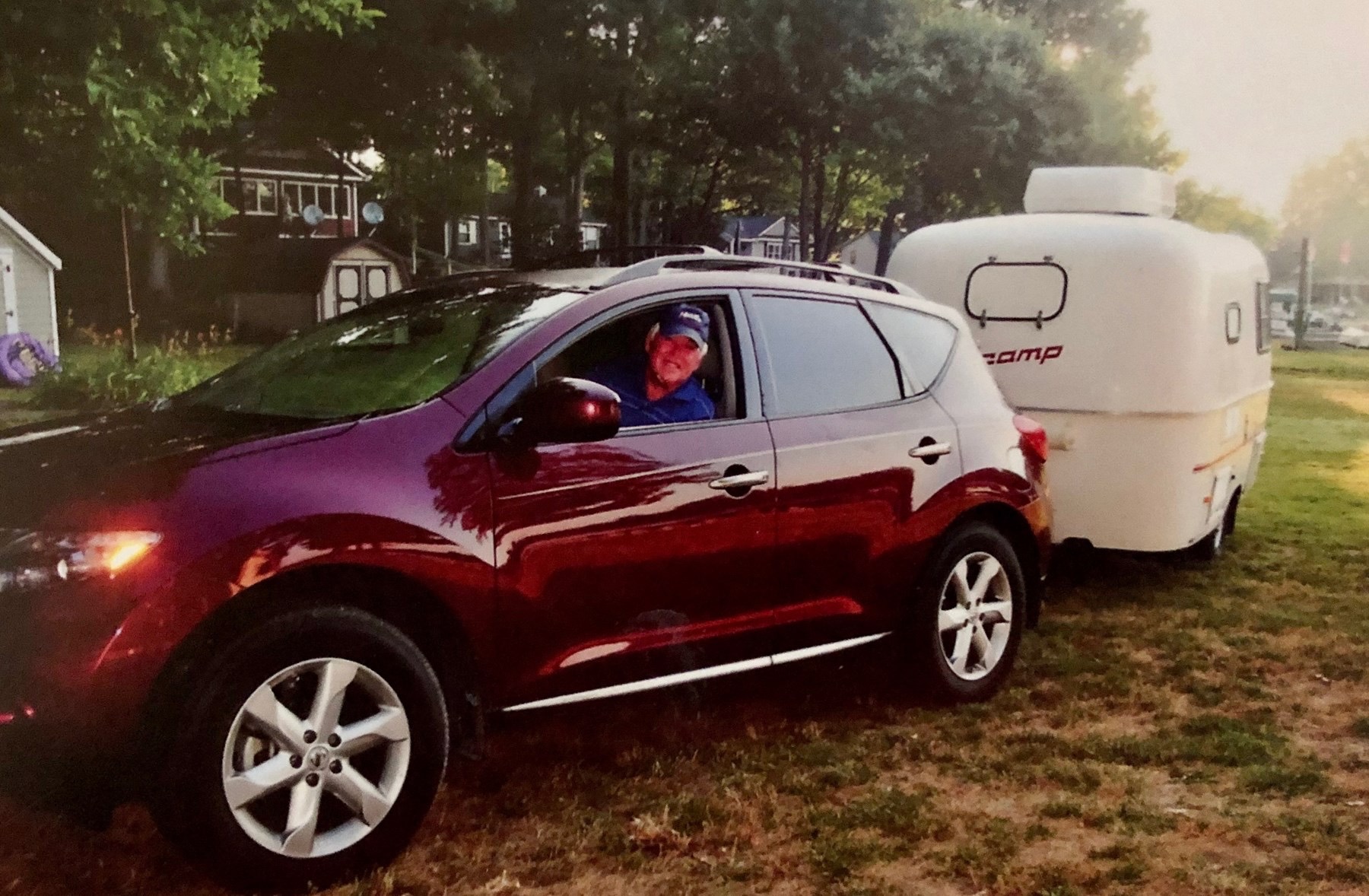
We were thrilled about his new purchase and the adventures it would afford him in the coming years, including several cross-country trips to see friends and family as far west as New Mexico and Arizona and as far north as Michigan. We were also excited about the prospect of borrowing it for our own camping excursions, and he quickly made it clear we could take it out at any time.
In 2012, we accepted his offer and borrowed the Scamp for a two-week trip to New Mexico and Colorado. It would be the first of many adventures and spark our interest in becoming Scamp owners ourselves.
From newbies to pros
On Sept. 1, 2012, Sandy and I hooked up the Scamp to my Subaru Outback and readied for a long drive out West.
Dad had instructed me on towing and operating the Scamp. He showed me how to level it, hook up to shore power, connect the propane, operate the refrigerator, and so on. He wrote it all down in a notebook that we pored over before the trip and referenced several times during our travels to ensure we knew how to run every aspect of the cooling, water, and electrical systems.
Still, that first night, in a KOA outside Oklahoma City dotted with massive rigs that dwarfed our tiny trailer, we had no clue what we were doing. Operating a camper, however small and simple it may be, was nerve-wracking for a couple of dirtbags who had only slept in tents or on the ground.
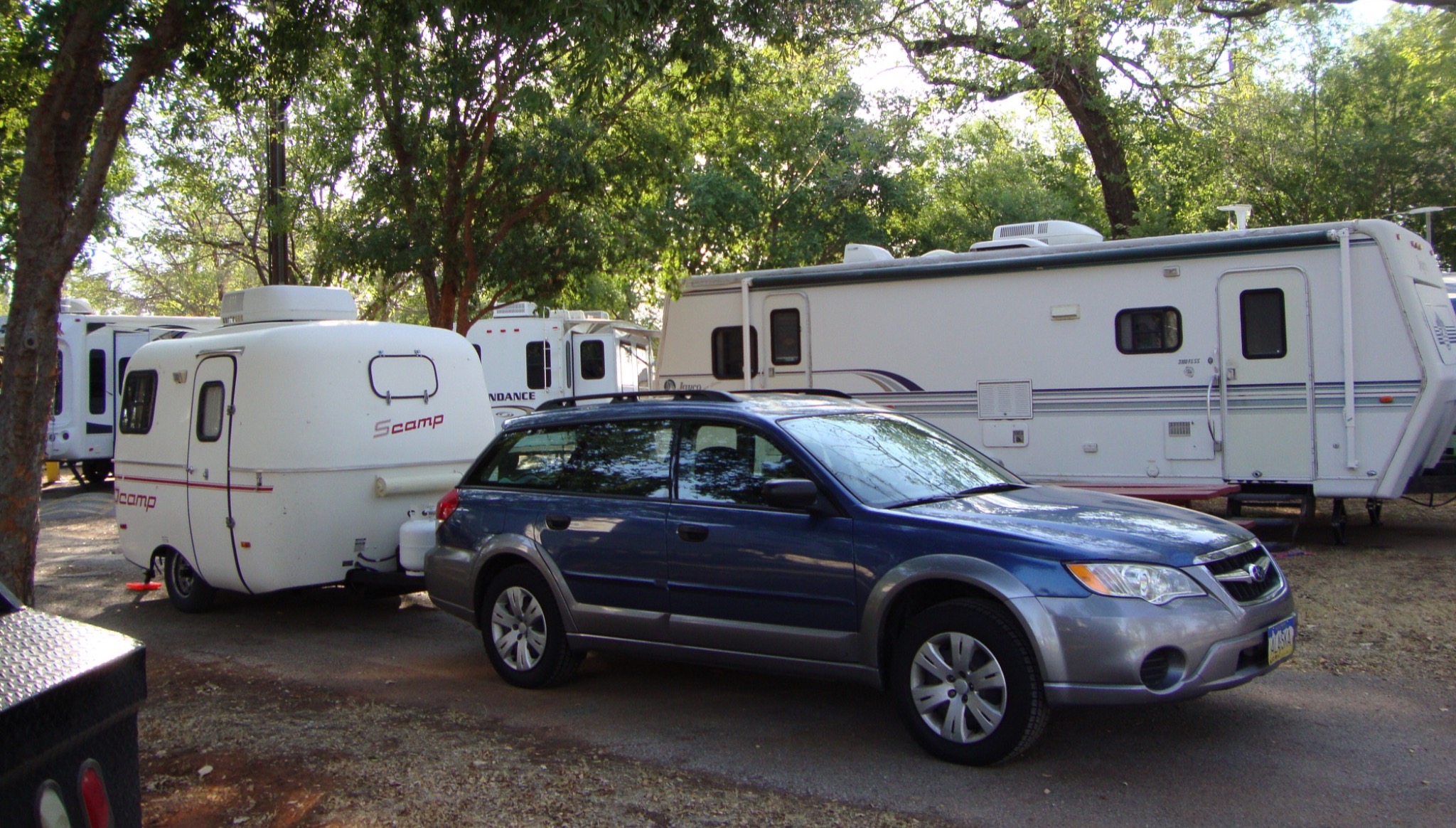
Thankfully, we were en route to see my Uncle Rick and Aunt Kathy in Albuquerque, N.M. From there, the four of us drove an hour north to a campground outside Santa Fe. At camp, Rick, who had a slide-in camper in the back of his pickup, showed me even more about the Scamp’s operations and answered my many, many questions.
After a few days with Rick and Kathy, they headed home, and we headed north to Taos, where our adventure continued. Each day on the road and at camp, we grew increasingly comfortable with the Scamp, from backing it into a campsite to keeping it level to using all its amenities.
From Taos, we drove to Crested Butte. During that leg, I learned—not quite the hard way, but almost—that towing a Scamp means opting to get gas even when you think you’ve got enough to reach the next destination. I wrote about that near misadventure in a very short blog I launched long before “A Fan’s Notes,” called “The Road Always Leads to Crested Butte.”
At the end of that piece, I noted the blog was “to be continued,” yet I never followed up on that promise. Not until now.
After a few nights in Crested Butte, we spent some time in Breckenridge and then made the long trek back to Memphis with two pressing thoughts in our heads: 1) We needed to move to Colorado; 2) We needed a Scamp of our own.
Both would soon come true.
Our adventure basecamp
Following the success of our epic two-week trip in New Mexico and Colorado, Sandy and I borrowed the Scamp several other times to venture into the woods near Memphis with our good friends Todd Nations and Jeremie Upshaw, who owned a Midas pop-up camper.
In the fall of 2014, we moved to Louisville, Colo., just outside Boulder. We accomplished our first goal of moving to Colorado; now, we just needed a Scamp of our own to explore our new home state.
We even began looking for used ones to purchase, but in July 2015, Phil announced he was retiring from Scamping after five years. Operating it had become too much for him, and his new “wife” hated the Scamp. (I didn’t mention this in my blog about her, but it was another reason we despised her.)
Then he told me something I’ll never forget: He wanted Sandy and me to have the Scamp. He was going to pass it down to us.
We were bummed he was giving it up, but we also knew things were changing in his life. We mostly couldn’t believe our luck, especially when he drove it out that summer and officially signed the title over to me.
The Scamp was ours. And it has been ever since.
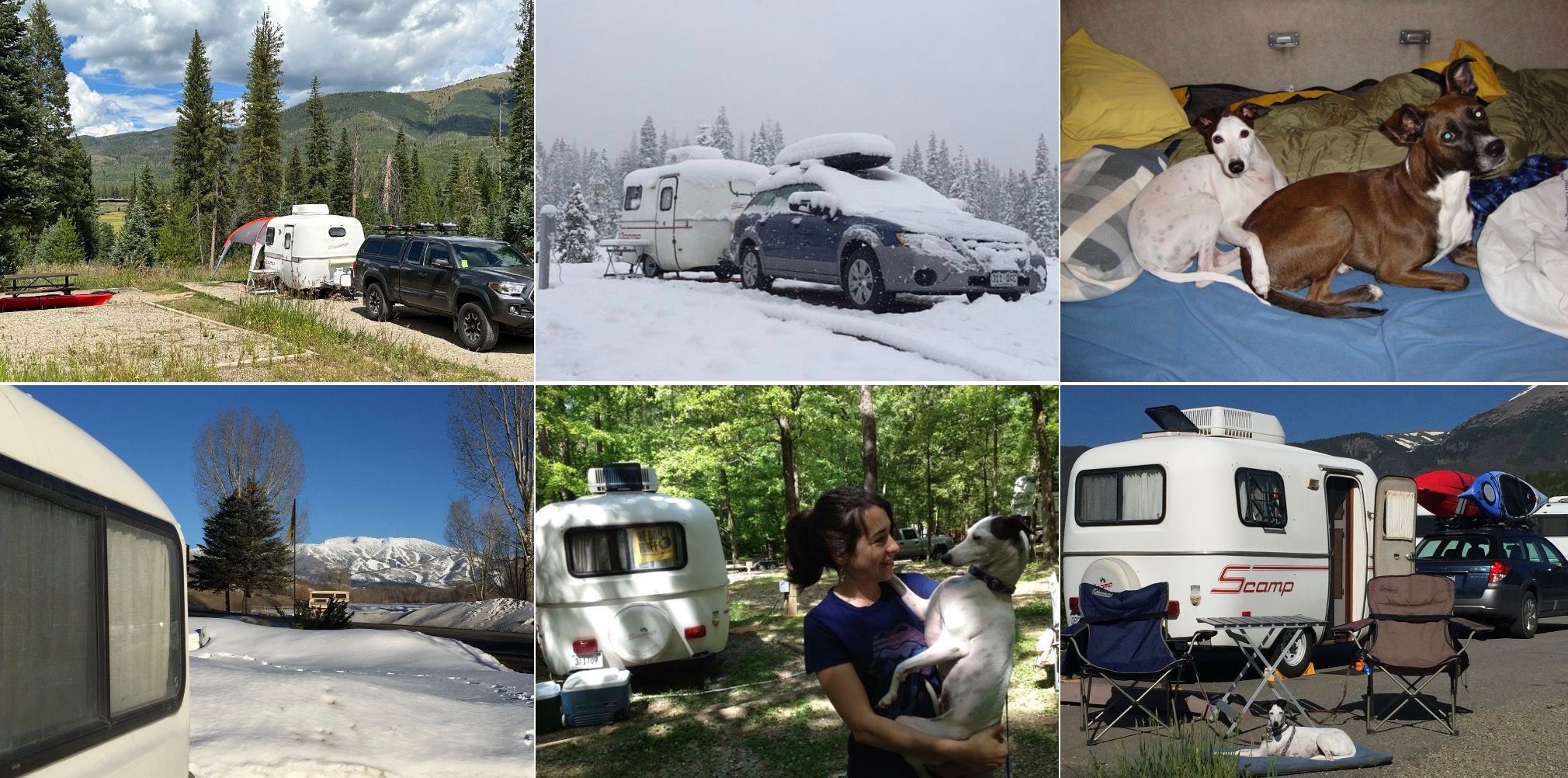
Over the past decade, we’ve taken the Scamp on dozens of trips. Some summers, we Scamp more than others, but we average four to five adventures a year, though occasionally, we hit double digits. All told, we’ve slept close to 200 nights in the Scamp, the equivalent of more than six months living in our tiny home away from home.
The Scamp is our getaway vehicle. Literally. Though we mostly stay at campgrounds, meaning we’re not entirely off the grid, the camper allows us to escape the din of the city and the drudgery of our jobs. And it helps us connect—with each other, with our pups, with nature, and with our Colorado home. The Scamp has been our saving grace after many harried workweeks.
And it’s not just for summer adventures. We’ve driven the Scamp to Steamboat Springs for ski trips. We camped in freezing temps at night only to wake up and hit the slopes 15 minutes away.
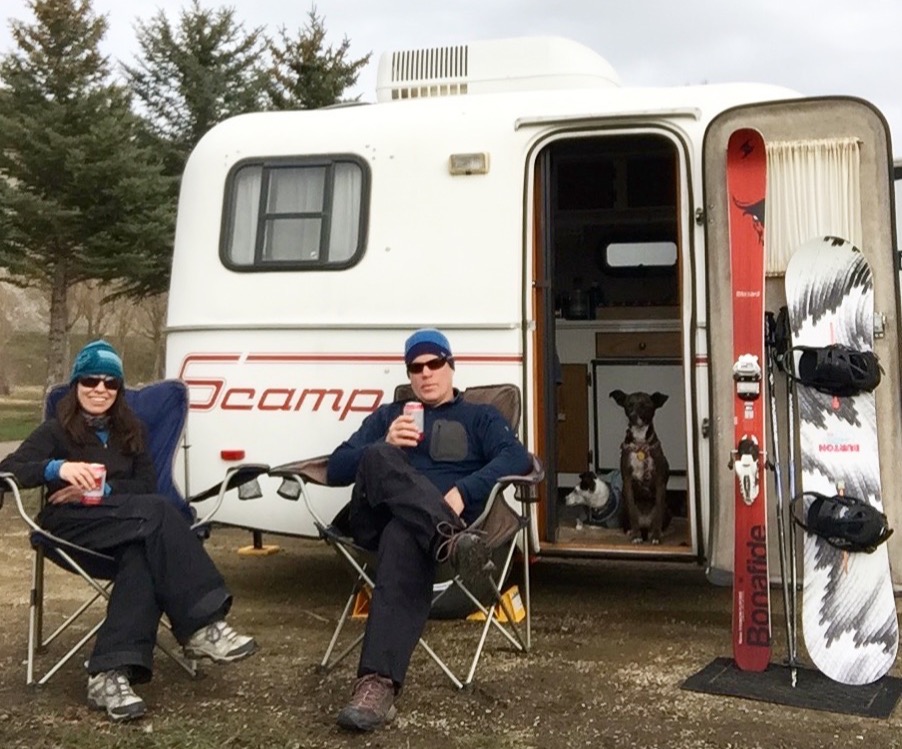
The Scamp has been our basecamp for kayaking, biking, and hiking trips, and it’s always been there to keep us warm, dry, and fed after a long day on the trail or the water, no matter what kind of weather we endured during our adventure or what awaited us back at camp.
We’ve taken it out in nearly every condition our home state of Colorado throws at us. With its furnace, bathroom, and kitchenette, the Scamp has everything we need and nothing we don’t. It’s truly a Scamp for all seasons.
Another season underway
Over the past few years, we kicked off the summer by driving to the East Portal Campground in Estes Park, Colo., the gateway to Rocky Mountain National Park, for Memorial Day weekend.
That’s where we were again last week to begin the 2025 season. It rained much of the time, forcing several tent campers to pack up and head out early, their gear waterlogged and spirits dampened, but we were warm and dry inside our Scamp.
We have several other trips planned for this summer, and we’re even starting to discuss buying a slightly larger version (the 16-foot Scamp) to provide us with more space while camping.
No matter what comes next—whether we get a bigger Scamp or stick with the original—we’ll always be a fan of the camper that’s helped us explore new and familiar places, all while serving as a reminder of my Dad, who died in 2019 but whose spirit lives on whenever we take it out.
Every Scamp trip, we can’t help but reflect on that moment in Alaska 16 years ago when this camper serendipitously entered our lives. And, of course, we can’t help but think of Phil, who bought a Scamp on our recommendation and ultimately handed it down to us after we moved west to Colorado.
It’s why, on the first night of each camping trip, we raise a glass to Phil, marvel at how we ended up as fans and owners of a Scamp, and dream about new adventures that are waiting just around the next bend.


Post a comment